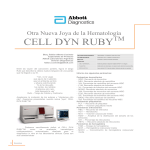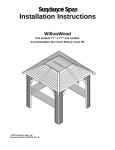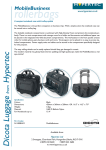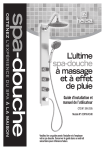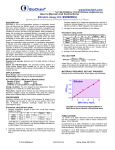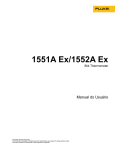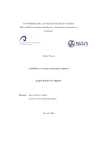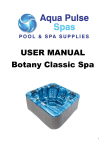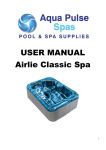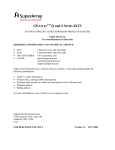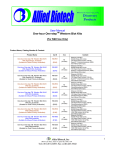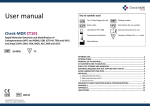Download VisPROTM 5 minutes Protein Stain Kit
Transcript
VI UAL PROTEI N VP1005-500 / VP1005-125 VisPROTM 5 minutes Protein Stain Kit 5X concentrate,1 nano gr am gr ade Switch NOW to VisPRO 5 minutes Protein Stain and See how it changes your researches!!. Visual Protein Biotechnology Corp Innovation & Incubation Center, No.510, ZhongZheng Rd., XinZhuang City, Taipei County 24299, Taiwan. P.O. Box 1-239 XinZhuang, Taipei County 24299, Taiw an. www.visualprotein.com Tel: +886-2-8660-6212 Fax: +886-2-8660-2947 Introduction VisPROTM 5 minutes Protein Stain Kit (1 nanogram grade) provides a quick and easy way to read your protein gel. No fixation is required. Simply add the pre-made solution to your gel, and find the protein bands or spots in less than 5 minutes. VisPROTM 5 minutes Protein Stain Kit applies the principle of zinc stain, a negative stain method. The formation of zinc-imidazole complex on polyacrylamide turns the gel to white, while the protein area prevents the stain and remains transparent. VisPRO 5 minutes Protein Stain Kit perfectly matches to current proteomic research. Generally, more protein spots can be detected in 2-DE gels by this robust staining method than silver and Sypro Ruby stain. Moreover, the unfixing nature has it very ideal for subsequent analysis by mass spectrometry. Proteins developed by VisPROTM 5 minutes Protein Stain usually have higher rate of good annotation. VisPROTM 5 minutes Protein Stain Kit is also compatible to other techniques. The stained gel can be electro-eluted for recovering proteins, or electro-transferred onto PVDF or nylon membrane for Western blotting. The stained gel is also re-stainable by VisPROTM 5 minutes Protein Stain, and all other known staining methods, such as Coomassie brilliant blue stain, silver stain and Sypro Ruby stain. Switch NOW to VisPROTM 5 minutes Protein Stain and See how it changes your researches!! Product component VisPROTM 5 minutes Protein Stain Kit (1 nanogram scale) (VP-1005-500) Solution I (5X Sensitizing Solution) VP-1005-1-500 500ml 1 bottle Solution II (5X Developing Solution) VP-1005-2-500 500ml 1 bottle User’s manual 1 booklet VisPROTM 5 minutes Protein Stain Kit (1 nanogram scale) (VP-1005-125) Solution I (5X Sensitizing Solution) VP-1005-1-125 125ml 1 bottle Solution II (5X Developing Solution) VP-1005-2-125 125ml 1 bottle User’s manual 1 booklet *Please 5X dilute with ddH2O before using. Safety Information Please wear gloves, lab coat and goggles while operating. Prevent contact product directly. In case of contacting, wash with large amount of water. Storage VisPROTM 5 minutes Protein Stain Kit can be stored at room temperature. Please use up the opened product in 2 years. Rock the bottle gently before using. Instruction I A. Quick Staining Protocol 1. Dilute 1 volume of 5X VisPROTM with 4 volume of ddH2O before using. 2. After electrophoresis, move the gel into staining box with dark background. (Black staining box is available. BS1001/BS1002) 3. Add Solution I to immerse the gel. Generally, 20 mL is sufficient for one 8 x 10 cm gel. Gently agitate the staining box (50-75 rpm) for 5 minutes. 4. Discard Solution I. Wash the gel briefly with ddH2O for 5 seconds. 5. Add Solution II directly into the staining box. Solution II “SHOULD NOT” be poured directly onto the gel surface. It will cause uneven background. Vigorously agitate the staining box by hand. The background of gel should turn white and the protein bands or spots should be visualized in less than 20 seconds. 6. Discard Solution II immediately. Wash the gel twice with ddH2O. 7. Store the gel in ddH2O. Depending on the quality of distilled water, the stained image can be sustained without protein diffusion from weeks to months. For better storage, stained gel can be sandwiched between two transparency sheets and ziplocked in a plastic bag at 4 C.In this way, gel images can be clearly discerned after months.It is possible to perform manual spot-picking from the stored gels. B. Highly Sensitive Staining Protocol 1. Dilute 1 volume of 5X VisPROTM with 4 volume of ddH2O before using. 2. After electrophoresis, move the gel into staining box with dark background. (Black staining box is available. BS1001/BS1002) 3. Add SDS electrophoresis buffer (Tris/glycine buffer), 100 ml for one 8 X 10 cm gel. Gently agitate the staining box (50-75 rpm) for 5 minutes. 4. Discard SDS electrophoresis buffer. 5. Add Solution I to immerse the gel. Generally, 20 ml is sufficient for one 8 x 10 cm gel. Gently agitate the staining box (50-75 rpm) for 5 minutes. 6. Discard Solution I. Wash the gel briefly with ddH2O for 5 seconds. 7. Add Solution II directly into the staining box. Solution II “SHOULD NOT” be poured directly onto the gel surface. It will cause uneven background. Vigorously agitate the staining box by hand. The background of gel should turn white and the protein bands or spots should be visualized in less than 20 seconds. “DO NOT” develop more than 1 Minutes, or it will cause overstaining. 8. Discard Solution II immediately. Wash the gel twice with ddH2O. 9. Store the gel in ddH2O. Depending on the quality of distilled water, the stained image can be sustained without protein diffusion from weeks to months. For better storage, stained gel can be sandwiched between two transparency sheets and ziplocked in a plastic bag at 4 C.In this way, gel images can be clearly discerned after months.It is possible to perform manual spot-picking from the stored gels. Important notification for staining 2-DE gels !! In some circumstance, the pH value and wetness of 2-DE gels are greatly changed during long time of electrophoresis. It is highly recommended to tuning your 2-DE gel conditions by submerge it in SDS electrophoresis buffer (Tris/glycine buffer) for 5-10 minutes before adding Solution I. It is not required to wash the tuned gel before adding Solution I. 20 mL,50 mL and 100 mL of Solution I/II are sufficient to stain 8x10cm,16x18 cm and 24x20 cm 2-DE gels, respectively. Because the 2-DE gels is often thicker, it is recommended to extend incubation of Solution I to 10-15 minutes for better staining results. It is recommended to cut the desired protein spots for the stained gel right after the staining. C. Image acquisition 1. Scan the stained gel in the flatbed scanner with transparency unit at transparent mode. Turn on the option of reversing image. (recommend instrument) 2. When using CCD camera to document the gel image, a black background has to be place under the gel. However, the obtained gel image generally has less contrast. D. Destaining and Restaining I. Destaining by SDS electrophoresis buffer (regular Tris/Glycine buffer with SDS) 1. The stained gel can be destained by SDS electrophoresis buffer in minutes. 2. If restaining of gel is required, just following the staining procedure starting from Solution I. II. Destaining by 10% acetic acid 1. The stained gel can also be destained by 10% acetic acid in less than 1 minute. Fixation of protein will occur at the same time. 30 minutes fixation should be sufficient for complete immobilization of proteins. 2. If restaining of the acetic acid fixed gel is required, wash the gel three times by distilled water for 10 minutes. Equilibrate the gel in SDS electrophoresis buffer 5 minutes before restaining. E. Visualize your gel 1. The location of protein on the stained gel can be easily visualized by eyes under black background, such as in the black staining box (BS1001/BS1002). 2. When spot picking is desired, it is recommended to use gel light plate (GL1001) for best visual effect. Other downstream applications FAQs about VisPROTM 5 minutes Protein Stain Kit A. Mass spectrometry 1. Move the cutting protein spots or bands into micro centrifuge tube (Eppendorf brand is recommended.) 2. Destained and fix the gels in 10% acetic acid for 30 minutes. 3. Wash the fixed gel thoroughly with three changes of ddH2O. 4. The washed gel can then be stored at -20 C or processed directly according to the standard mass sample preparation procedure. B. Electroelution / Electroblotting 1. Before electroelution or electroblotting is performed, Wash the gel 10 minutes by Tris/glycine buffer (without SDS). 2. Perform electroelution or electrobltting according to standard procedures. C. Restaining by other staining methods 1. Fix the gel by 10% acetic acid for 10 minutes before performing Coomassie brilliant blue stain, silver stain, Sypro Ruby stain or other staining method. 2. Destain the gel by Tris/glycine buffer (without SDS) if activity stain is required. Trouble shooting Possible cause Remedy Background is too white and the contrast is poor. The gel may be overdeveloped. The optimal development by Solution II should be restricted to about 20-30 seconds. Background is not white and the contrast is poor. The pH of the original gel might be drifted (too acidic). The original gel is too dry. Tuning your gel in SDS electrophoresis buffer before staining. Uneven background 1. Solution II is poured directly onto gel surface. 1. Pour Solution II into area of staining boxes without gels. 2. Add Solution II quickly. 2. The addition of Solution II is too slow. 3. The agitation of Solution II is not vigorous enough. 3. Agitation vigorously when Solution II is added. 4. Wear gloves. Clean all 4. The contamination of glassware and eletrophoprotein from environments. retic apparatus. Please note! All unsatisfactory stained gel can be destained by SDS electrophoresis buffer and restained again. Accessories Size: 297L*210W mm Appendex A 1. Fernandez-Patron C., Castellanos-Serra L., Rodriguez P. BIOTECHNIQUES 1992 ;12 :564-573. 2. Ching-Yu Lin, Vinchi Wang, Hao-Ai Shui, Rong-Huay Juang, Ai-Ling Hour, Pei-Sing Chen, Hui-Ming Huang, Szu-Yu Wu, Jen-Chieh Lee, Tzung-Lin Tsai and Han-Min Chen. PROTEOMICS 2009; 9:696-709. 3. Yi-Jen Liau, Lisa Wen, Jei-Fu Shawc, Chi-Tsai Lin. Journal of Biotechnology, 2007 ; 131:84–91. 4. Shih Chung Chen, Bin Huang, Yu Chi Liu, Kou Gi Shyu, Pen Y. Lin and Danny Ling Wang, Biochemical and Biophysical Research Communications 2008 ; 377:1274-1278. 5. Ching-Yu Lin, Hui-Ming Huang, and Han-Min Chen. BIOTECHNIQUES 2006; 41:560-564. Appendex B 1. How can I digitalize VisPRO stained gel images? What instruments are needed? Ans: Option 1: We suggest using a flatbed scanner with transparency unit to document the reverse stained gel images. While scanning, turn on the transparency mode and save the image into 8 or 16 bit grayscale TIF file. For optimal image quality, stretching the level of image to maximal (0-255) is suggested before saving the files. Option 2: Gels can also be documented by flatbed scanner without transparency unit. However, a black background should be placed behind the gel while scanning. Note: Using a CCD camera to capture gel images is not recommended. Central light spots on the documented images are generally observed from the reflection of epi light source. 2. How can I store the stained gels? Ans: Option 1: For long term storage, stained gel can be sandwiched between two transparency sheets and ziplocked in a plastic bag at 4 C. In this way, gel images can be clearly discerned after months. It is possible to perform manual spot-picking from the stored gels. Option 2: Stored in solutions like distilled water is not recommended. However, the reverse stained gel can be preserved in distilled water for weeks. Sometimes fading of gel image may be observed for laboratories equipping with distilled water of pH lower than pH 7. Switching the storage solution to 100 mM Tris buffer at pH 7.2 might remedy above fading phenomena. 3. How can I see stained gels more clearly when I pick protein spots in-gel? Ans: We recommend using the Gel Lighting Plate (Product code: GL1001) to visualize the gel. It has been proved that gel lighting plate is excellent for direct observing the reverse stained gels. (Reference: Ching-Yu Lin, Hui-Ming Huang, and Han-Min Chen. Use of backlit light plate to enhance visualization of imidazole-zinc reverse stained gels: BioTechniques 41:560-564 (November 2006). 4. Why the sensitivity of stain doest not reach to 1 ng of protein as claimed? Ans: The gel is over stained! VisPRO 5 minutes Protein Stain is a negative staining method. The gel background is the target; proteins are not the staining targets. Over-staining will decrease the sensitivity. The optimal development time by Solution II limits to 20-30 seconds. It should not exceed 60 seconds. 5. Why the background of my gel did not turn white within 30 seconds? Ans: The pH is drifted. VisPRO 5 minutes Protein Stain is highly sensitive to the changing of environment pH. At acidic environment, it takes longer than 30 seconds for turning the background of gel to white. Either the electrophoretic gels become acidic due to prolonged electrophoretic procedure, or the mild acidic distilled water may result in the pH drifting to acidic. Note: We recommend to soak the electrophoretic gels into the SDS electrophoresis buffer (containing glycine, tris and SDS, pH 8.4) for 10 minutes before performing VisPRO 5 minutes Protein Stain. Generally, employing such procedure, all gels can be developed within 30 seconds with excellent results. 6. Why does gel present uneven and mist-like background after staining? Is it remediable? Ans: It might happen if pouring Solution II directly onto gel surfaces, or agitating is not vigorous enough while development. You can destain the gel and then restain it according to the manual’s instructions. 7. Can I stain the acidic fixed gels by VisPRO 5 minutes Protein Stain Kit? Ans: Definitely! You should wash the fixed gel thoroughly by distilled water of 10 minutes for three times, and then equilibrate the gels in SDS electrophoresis buffer for another 10 minutes. The washed gels can be subsequently developed by VisPRO 5 minutes Protein Stain Kit following the standard staining protocol. 8. Why I can’t re-stain the acidic fixed gel as claimed? Ans: Insufficient washing may result in an acidic environment residing in the gels. Just performing another thorough washing by distilled water and equilibrating by SDS electrophoresis buffer may remedy. 9. Can I use VisPRO 5 minutes Protein Stain Kit for gels from electrophoresis conditions other than Tris-Glycine-SDS system? Ans: Definitely! However, you should wash such gels by distilled water for 10 minutes, and equilibrate in SDS electrophoresis buffer for another 10 minutes. The washed gels can be subsequently developed by VisPRO 5 minutes Protein Stain Kit following the standard staining protocol. 10. What is the dynamic range of staining for VisPRO 5 minutes Protein Stain Kit? Ans: Generally, the dynamic range of staining for VisPRO 5 minutes Protein Stain Kit is from 0 to 200ng, which is better than silver stain (< 100 ng) 11. How should I prepare the VisPRO stained gel for downstream analysis of mass spectrometry (MS)? Ans: 1.Move the cutting protein spots or bands into micro centrifuge tube (Eppendorf brand is recommended.) 2.Destain and fix the gels in 10% acetic acid for 30 minutes. 3.Wash the fixed gel thoroughly with three changes of ddH2O. 4.The washed gel can then be stored at -20 degree C or processed directly according to the standard mass sample preparation procedure. 12. How can I destain the reverse stained gels? Ans: Option 1: Destaining by SDS electrophoresis buffer (regular Tris/Glycine buffer with SDS) for 10 minutes. This destaining method is used where restaining by VisPRO 5 minutes Protein Stain or membrane transferring is required. Option 2: Destaining by 10% acetic acid for 5-30 minutes. This destaining method is used where fixing of the protein is required, such as preparing the samples for mass spectrometry (MS) or restaining by other gel staining methods, such as silver stain, CBB stain or Sypro RubyTM stain.



